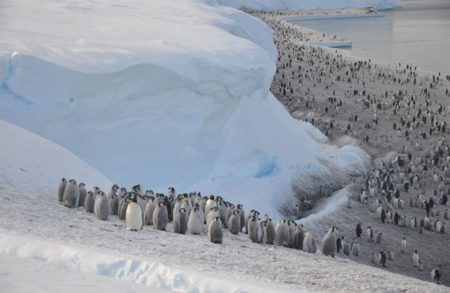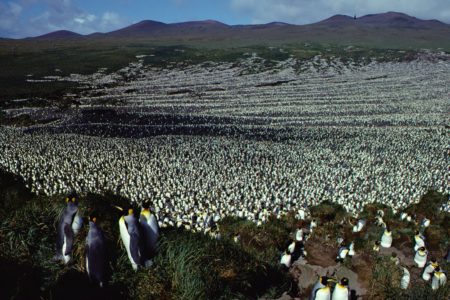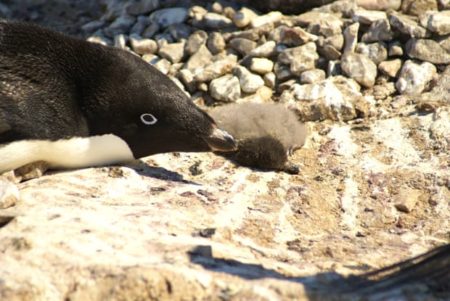June 18, 2019 – Anna Kucirkova sent us her first guest contribution to 21st Century Tech Blog just one week ago. And now she is back with a second article that looks at the world’s population of penguins and how what is happening to them because of our warming atmosphere should be of concern to all of humanity. Anna’s background includes a facility in three languages, copywriting, and travel. I hope you find this second posting of hers to be of interest and welcome your comments.
Change in climate is greatly impacting Penguins, the lovely flightless birds loved by almost every adult and child who sees them in zoos and animal theme parks. They have been described as the clowns of the bird world, or the head waiters. Penguins may look awkward with their funny walking style on land, but in the ocean they are extraordinary swimmers.
Penguins live in colonies. In the water, they often form floating communities called rafts. Their main diet is fish and krill which they hunt for by diving to depths of 500 meters underwater and staying below for up to 20 minutes.
In penguin colonies, the appearance belies the reality. You see chaos. Penguins don’t they can hear distinct sound patterns from their mates to find them. Even chicks can identify their mothers by sound within a crowd.
Today there are 17 penguin species with the majority living in the Antarctic. But scientists based on declining numbers in penguin colonies are asking a troubling question, “Could the Antarctic lose most of its penguins?” The evidence is pointing to colony collapse in several penguin species including Emperor, King, and Adelie.
The back story to why penguin colony collapse is being observed
The decline of the three separate penguin species has prompted questions about how climate change is impacting the species. Or could there be other reasons causing population decline? And if so, can human intervention help to ensure the survival of these three species?
1. Emperor Penguins
The Emperor is the largest of all penguin species. The concern about colony collapse first hit the headlines when it was discovered that the second largest colony of these remarkable birds had almost disappeared. A survey done in 2016 by a British team of researchers revealed the death of thousands of Emperor Penguins linking their demise to drowning from melting ice platforms where the birds breed. In the past the ice lasted from April when the penguins arrived through to December when the chicks fledged. But a storm in the Weddell Sea destroyed a nesting ice shelf with the research team reporting, “Penguins have been unable to raise chicks in the last 3 years,” and noting that “the whole colony has now all but disappeared.”

2. King Penguins
The King is the second largest penguin species. Its largest colony found on the Ile aux Cochons (Pig Island) has seen a tremendous population decline in the last few decades. This area is a French territory that is part of the Crozet archipelago in the southern Indian Ocean between South Africa and Antarctica, is home to one-third of all King Penguins on the planet. But in the last 30 years, at least 85-90% of the colony has disappeared. In the 1980s about two million birds lived on the island, but 2018 satellite imagery estimates that number has declined to 200,000. The suspected main cause of the decline – global warming.

3. Adélie Penguins
The Adélie species has had its own survival trials with recent population declines from the birds being cut off from the open sea by changes to the ice along the edge of Antarctica. The Adélie is considered by scientists to be a good indicator of environmental changes because the species ecology is closely linked to the state of sea ice off the coast of the southern continent. And in recent years two massive breeding failures, with no chicks surviving the 2013–14 and 2016–17 breeding seasons, is being attributed to the extent of sea ice in front of the colony that persisted throughout the breeding cycle of the birds blocking them from getting to the ocean easily to feed. One of the peculiarities of the Antarctic response to global warming isn’t less sea ice, but more in the Southern Ocean. That’s because more melting is occurring on land-based ice and ice shelves introducing significant quantities of freshwater into the neighbouring ocean which then freezes more rapidly than the underlying salt water.

In the case of all three colony collapses there is mounting demand for the Antarctic Treaty nations to create new marine protected areas, particlulary in East Antartica which would match the largest protected marine environment adjacent to the continent today in Antartica’s Ross Sea.
Addressing climate change and other challenges
Can we find solutions to stop these declines?
The answer is yes if we tackle the challenge of climate change. If we can reduce greenhouse gas emissions significantly in the next few decades, in time we can help to restore the land ice to sea ice balance along the edges of Antarctica.
But there remains another challenge that if not addressed will leave the penguins of the Southern Hemisphere at extreme risk of starvation. That is ensuring a healthy population of krill in the Southern Ocean. With some fisheries exploiting krill to extract oil for health supplements, we are putting further pressure on penguin populations.
Is there any hope?
Penguins could turn out to be resilient without much help from us. Recently, scientists have observed penguin colonies migrating to other regions of Antarctica and islands in the Southern Ocean.
An Emperor colony 54 kilometers (34 miles) from Halley Bay, the location of the first colony collapse, is increasing in population dramatically. A recently discovered colony of Adélie has been found living in the Danger Islands off Antarctica. The colony population estimate is over 1.5 million birds and growing. As for King penguins, they have recolonized Heard Island off Patagonia and have seen the dramatic growth of the colony on Spit Island off South America. So it seems if the birds can find sheltered and stable areas with access to the open ocean to feed, they have the ability to restore a healthy population. What we have to do is keep monitoring them by satellite and drone to ensure their survival.
To read more about penguins and the challenges they face please visit here.















